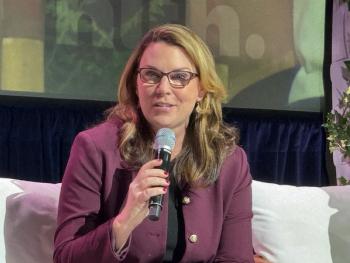
Connecting the Dots: Cambia Grove Hosts Deep Dive on Data Interoperability
A look at data interoperability and how the industry will move forward.
Photo/Thumb have been modified. Courtesy of Dmitry - stock.adobe.com.
Interoperability & the Human Cost of Incomplete Data
Somewhere amid the hot flashes and chills, Christine Bechtel’s golfing buddy, Becky, lost her longtime taste for whiskey. Symptoms small enough to ignore, until one day Becky passed out on the kitchen floor. Chalk it up to menopause, her primary care provider said. See an OB-GYN. Ask a neurologist. Consult an endocrinologist.
Lacking the full picture of her health, the deep bench of specialists — with no way to easily share data between each other — was no match for Becky’s undiagnosed stage 4 lymphoma. But if you search hot flashes, loss of taste and her other symptoms in Google, lymphoma pops up. Becky’s story hammers home the unavoidably human element in healthcare’s data sharing problem: tragic and costly health outcomes.
Dataflow’s Watershed Moment
2019 marked a hallmark year for data exchange and interoperability, as the
To help consumers and healthcare stakeholders understand impending changes to the application of health data,
Expanding the Data Pipeline
Susannah Fox opened the conference by gauging the data literacy of the current health data system. She compared our knowledge of the
Fox spoke of expanding our health data horizons and a new taxonomy of health data, one including grocery and gym habits. In Japan, for example, if a senior citizen hasn’t used electricity by the standard time their records routinely show usage in the morning, help is dispatched.
Perhaps the most well-known example of health data access is Blue Button 2.0 — a Centers for Medicare & Medicaid Services (CMS) initiative to boost consumer-directed health record sharing. Aneesh Chopra launched the original Blue Button initiative in the Veteran’s Administration in 2010 and shared how simplifying consumers’ access to their own data has evolved since. When he last visited Cambia Grove in 2017, he discussed that
Breaking Down Barriers With a “FHIR” Hose
Interoperability has the power to integrate medical claims data from providers, provider network data, medication and prescription data, pricing information, and more. Organizations like
Members of the Da Vinci Project are forging industry-first interoperability use cases such as
By combining disparate health data sources into one portable 360-degree view of health history, consumers can easily access records and are more likely to change their behavior based on having that access. Solutions offering a one-stop shop for health data improve not just health outcomes, but their business case as well. Drawing on her experience caregiving for her two elderly parents and aging sister, Bechtel encouraged entrepreneurs to “solve real problems for real people. Then you don't have to engage them, they'll come to you.”
Where Do We Go From Here?
There’s much work to be done as technology continues to transform healthcare. People now demand the same seamless, easy-to-understand, personalized consumer experience they have in other areas of their lives for making their healthcare decisions. We all deserve to be just as informed as our counterparts in the
“As we have heard time and time again, the technology is there,” Little said. “Partnerships are key in turning possibilities into practice. Cambia Grove will continue to bring together these essential connections to advance a more person focused and economically sustainable healthcare system for all.”
For these partnerships to take root entrepreneurs and organizations must reach common ground. Cambia Grove facilitated four interactive roundtables with summit attendees to name the barriers and unmet needs preventing interoperable innovations today. In order to design solutions that serve each sector of the health industry, we must consider each sector’s perspective before anticipating their needs.
12 Takeaways from the Interoperability Summit: The Road Ahead
*Strengthen the Business Case
- There needs to be a champion in all health organizations advocating for interoperability to advance value-based care.
- Consumers will benefit from interoperability as the payer and provider relationship improves through enhanced data sharing, communication and collaboration.
- Value-based care systems are only sustainable with a set framework for data exchange and interoperability.
*Technical Infrastructure
- Consumers need to be in control of their own data.
- Although data entry is the largest pain for providers (leading to problems in clinician burnout and poor clinic workflow), they are often not at the table during big data discussions. They need to be more present.
- There is increasing interest in using FHIR and how to use it to look inside big electronic health records (EHRs).
*Governance and Leadership
- Interoperability needs to be measured by individual organizations and at a national level. There should be a standard framework for these measurements.
- There needs to be involvement of consumers and community health centers regarding big data and interoperability to incorporate their perspective around how interoperability is used and measured.
- We need to be able to incorporate what happens outside of the clinic into patient health data (including SDOH).
*Policy and Regulatory
- Consumers need one way to identify themselves that can be authenticated and shared across systems.
- There needs to be more patient engagement around interoperability and the use of patient data.
About the Author:
Get the best insights in digital health
Related



































